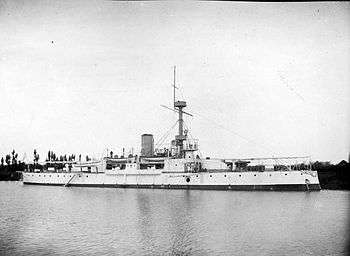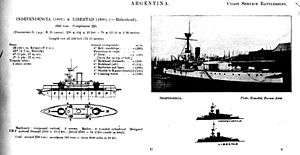ARA Libertad (1892)
 Riverine battleship Libertad circa 1893 | |
| History | |
|---|---|
| Name: | Libertad |
| Namesake: | Libertad, the Spanish word for "freedom" |
| Ordered: | 1889 |
| Builder: | Cammell Laird, Birkenhead, United Kingdom |
| Laid down: | 1890 |
| Launched: | 1892 |
| Completed: | 1892 |
| Commissioned: | 26 November 1892 |
| Decommissioned: |
1947 (Navy) 1968 (Coast Guard) |
| Fate: | Scrapped |
| General characteristics | |
| Type: | Riverine Battleship |
| Displacement: | 2336 tons |
| Length: | 73.15 m (240.0 ft) |
| Beam: | 13.55 m (44.5 ft) |
| Draft: | 3.96 m (13.0 ft) |
| Propulsion: | 2-shaft, 2 Vertical Compound steam engines, 3,000 ihp (2,200 kW), 4 boilers, 340 tons coal (maximum) |
| Speed: | 11 knots (13 mph; 20 km/h) |
| Range: | 3000 nautical miles @ 10kn |
| Complement: | 225 |
| Armament: |
|
| Armour: |
|
ARA Libertad was a battleship that served in the Argentine Navy between 1892 and 1947, and with the Argentine Coast Guard as a pilot station ship from 1947 to 1968. It was the seventh Argentine naval ship with this name.
Design

Libertad was a battleship designed mainly for coastal and riverine use, being classified by the Argentine Navy as “Riverine Battleship” (Spanish: Acorazado de Río); in the 1902 edition of Jane's Fighting Ships it was listed as “Coast Service Battleship”.
The ship was 73.15 metres (240 ft) long overall and 70.10 metres (230 ft) between perpendiculars,[1] with a beam of 13.11 metres (43 ft) and a draft of 3.96 metres (13 ft). Displacement was 2,370 tonnes (2,330 long tons).[2] It had a steel hull subdivided by transverse and longitudinal bulkheads, with a ram at its bow.[3] A 203 millimetres (8 in) thick armoured belt of compound armour, backed by 229 millimetres (9 in) of teak ran over two-thirds of the ship's length. The belt was 1.52 metres (5 ft) deep, with its upper edge just above the waterline. Armoured transverse bulkheads were at the fore and aft end of the belt, with the forward bulkhead being 203 millimetres (8 in) thick and the aft bulkhead 152 millimetres (6 in). An armoured deck ran the length of the ship, and was 25 millimetres (1 in) thick over the belt and 51 millimetres (2 in) thick at the ends of the ship. The ship's conning tower was protected by 102 millimetres (4 in) of armour, while the main guns were protected by 203–127 millimetres (8–5 in) thick barbettes topped by a 127 millimetres (5 in) armoured hood.44 millimetres (1 3⁄4 in) thick gunshields were fitted to the ship's secondary armament.[2][3]
The ship was propelled by two four-cylinder vertical compound steam engines, rated at 2,070 kilowatts (2,780 ihp), fed by steam from four cylindrical boilers. This gave a speed of 14.2 knots (26.3 km/h; 16.3 mph).[2][3] The ship had a single mast and funnel.[2] The mast differed slightly from the one in its sister Independencia.
As designed, its main battery had two 240mm Krupp guns (one at the bow and the other at the stern) on Vavasseur mountings protected with armoured shields, and two quick-firing 120mm Elswick guns on each side. The secondary battery had four 47 mm quick-firing Nordenfelt/Hotchkiss guns, and two 25mm Nordenfelt guns.
History
In July 1889, the Argentine Naval Commission in London signed a contract with the shipyard Cammell Laird of Birkenhead ordering the construction of "two twin-shaft, ram-equipped battleships for riverine service" (Spanish: ''dos acorazados de espolón de doble hélice para servicio de ríos) at a unit cost of £ 176.000; this transaction was approved in September of that year by the Ministry.
The first ship, then known as Nueve de Julio and later renamed Libertad when a new cruiser was assigned that name, started construction in 1890 and was launched in 1892; its construction was completed that year. After finalizing trials, in November 1892 the ship was formally accepted by the Argentine Navy, under command of Captain Atilio Barilari. It departed Liverpool on December 20, 1892 and arrived at Buenos Aires on January 25, 1893.

In mid-1894 the ship participated in the naval exercises as part of the 1st Division; later that year it joined its sister ship, Independencia, and the battleship Almirante Brown.
In 1905 it was assigned to the hydrographic survey of the Río de la Plata (English: River Plate); after that it was reassigned to the Training Division. In 1914, Libertad was assigned to train the crews for the new dreadnought battleships being built in the United States (Rivadavia and Moreno). In 1915 the ship was reclassified as a "coast guard ship". In 1918–19 Libertad was maintained in reserve, and by 1922–23 was assigned as training ship. In 1924-25 the ship was again in reserve, being upgraded to use oil fuel rather than coal. In 1927 Libertad was reclassified as a gunboat, and was assigned to the Gunboat Division in 1930.
In December 1946 Libertad was discharged from the Argentine Navy (decree 22.556) and in 1947 transferred to the Coast Guard, to be used as station ship for pilots in the River Plate. In 1968 the ship was discharged from the Argentine Coast Guard.
See also
References
Notes
Bibliography
- Arguindeguy, Pablo E.; Rodríguez, Horacio (1999). Buques de la Armada Argentina 1852-1899 sus comandos y operaciones (in Spanish). Buenos Aires: Instituto Nacional Browniano.
- Chesneau, Roger; Kolesnik, Eugene M., eds. (1979). Conway's All The World's Fighting Ships 1860–1905. London: Conway Maritime Press. ISBN 0-85177-133-5.
- Caillet-Bois, Teodoro (1944). Historia Naval Argentina (in Spanish). Buenos Aires: Imprenta López.
- "The Argentine Twin Screw Armour-Clad Ram Libertad" (PDF). The Engineer: 427–428. 18 November 1892.
- "The Gun Trials of the Twin-Screw Armour-Clad Ram Libertad" (PDF). The Engineer. 13 January 1893. p. 25.
Further reading
- Arguindeguy, Pablo (1972). Apuntes sobre los buques de la Armada Argentina (1810-1970) (in Spanish). Buenos Aires, Argentina: Comando en Jefe de la Armada.
- Burzio, Humberto (1960). Armada Nacional (in Spanish). Secretaria de Estado de Marina.
- Piccirilli, Ricardo; Gianello, Leoncio (1963). Biografías navales (in Spanish). Buenos Aires: Secretaría de Estado de Marina..
- Bóveda, Jorge Rafael (2009). "Las maniobras Navales de 1902. La evolución de las tácticas de la Armada Argentina ante el conflicto con Chile, 1881-1902". Boletín del Centro naval (in Spanish) (Nº 824).
- Burzaco, Ricardo and Patricio Ortíz. Acorazados y Cruceros de la Armada Argentina, 1881–1982. Buenos Aires: Eugenio B. Ediciones, 1997. ISBN 987-96764-0-8. OCLC 39297360. (in Spanish)
External links
- Battleship “Libertad” - Histarmar website (Historia y Arqueología Marítima - Acorazado de Rio Libertad) (accessed 2015-12-05)